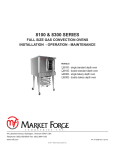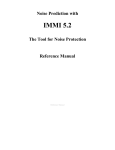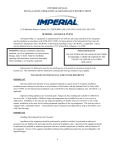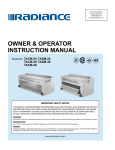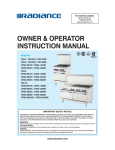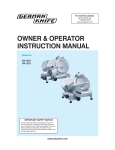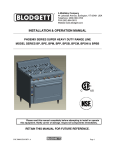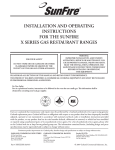Download Market Forge Industries MF-RG12-6 Specifications
Transcript
R SERIES HEAVY DUTY RANGES INSTALLATION - OPERATION - MAINTENANCE 24” MODELS 36” MODELS 48” MODELS 60” MODELS R-R4 R-R2G-12 R-RG24 R-R6 R-R4G-12 R-R2G24 R-RG36 R-R4RG12 R-R8 R-RG12-6 R-RG24-4 R-RG36-2 R-RG48 R-RRG24-4 R-R10 R-RG12-8 R-RG24-6 R-RG36-4 R-RG48-2 R-RG60 R-RRG24-6 44 Lakeside Avenue, Burlington, Vermont 05401 USA Telephone: (802) 658-6600 Fax: (802) 864-0183 www.mfii.com PN 14-0400 Rev A (9/14) © 2014 - Market Forge Industries Inc. Your Service Agency’s Address: Model Serial number Oven installed by Installation checked by TABLE OF CONTENTS IMPORTANT WARNING: Improper installation, adjustment, alternation, service or maintenance can cause property damage, injury or death. Read the installation, operation and maintenance instructions thoroughly before installing or servicing this equipment. INSTRUCTIONS TO BE FOLLOWED IN THE EVENT THE USER SMELLS GAS MUST BE POSTED IN A PROMINENT LOCATION. This information may be obtained by contacting your local gas supplier. FOR YOUR SAFETY Do not store or use gasoline or other flammable vapors or liquids in the vicinity of this or any other appliance. The information contained in this manual is important for the proper installation, use, and maintenance of this oven. Adherence to these procedures and instructions will result in satisfactory baking results and long, trouble free service. Please read this manual carefully and retain it for future reference. ERRORS: Descriptive, typographic or pictorial errors are subject to correction. Specifications are subject to change without notice. INSTALLATION Introduction.. . . . . . . . . . . . . . . . . . . . . . . . . . . . . . . . . . . . . . . . . . . . . . . . . . . . . . . . . . . . . . 2 Location.. . . . . . . . . . . . . . . . . . . . . . . . . . . . . . . . . . . . . . . . . . . . . . . . . . . . . . . . . . . . . . . . . 3 Dimensions and Burner Options. . . . . . . . . . . . . . . . . . . . . . . . . . . . . . . . . . . . . . . . . . . . 4 Utility Connections. . . . . . . . . . . . . . . . . . . . . . . . . . . . . . . . . . . . . . . . . . . . . . . . . . . . . . . . 5 High Shelf Assembly. . . . . . . . . . . . . . . . . . . . . . . . . . . . . . . . . . . . . . . . . . . . . . . . . . . . . . 7 OPERATION Operating Instructions. . . . . . . . . . . . . . . . . . . . . . . . . . . . . . . . . . . . . . . . . . . . . . . . . . . . . 8 MAINTENANCE Cleaning & Periodic Maintenance.. . . . . . . . . . . . . . . . . . . . . . . . . . . . . . . . . . . . . . . . . . 9 Introduction IMPORTANT INFORMATION SERVICE Safe and satisfactory operation of your equipment depends on proper installation. Installation must conform with local codes, or in the absence of local codes, the National Fuel Gas Code, (ANSI Z-223.1 Latest Edition). In Canada installation should conform to installation codes for gas burning appliances and equipment standard (CAN1-B149.1 Natural Gas) or (CAN1-B149.2 Propane Gas). Installation of the equipment should be performed by qualified, certified, licensed and/or authorized personnel who are familiar with and experienced in state/local installation codes. Operation of the equipment should be performed by qualified and authorized personnel who have read this manual and are familiar with the functions of the equipment. Service of the equipment should be performed by qualified personnel who are knowledgeable with Market Forge cooking equipment. The installation must conform with local codes, or in the absence of local codes, to the national fuel gas code, ANSI Z223.1 (or latest addenda). The Appliance and its individual shut off valve must be disconnected from the gas supply piping system during any pressure testing of that system in excess of 1/2 PSI (3.45Kpa). The appliance must be isolated from the gas supply piping system by closing its individual manual shut off valve during any pressure testing of the gas supply piping system at test pressures equal to or less than 1/2 PSI (3.45Kpa). The gas supply line must be at least the same size as the gas inlet of the appliance. Electrical wiring from the Electric Meter, main control box or service outlet to appliance must be electrically grounded in accordance with local codes or, in the absence of local codes, the National Electric Code (ANSI/NFPA 70 Current). In Canada wiring should conform with Canadian Electrical Code (CSA-C22.1). SHIPPING DAMAGE CLAIM PROCEDURE The equipment is crafted and inspected carefully by skilled personnel before leaving the factory. The transportation company assumes full responsibility for safe delivery upon acceptance of this equipment. If shipment arrives damaged: Visible loss or damage: Note the damage or loss on freight bill or express delivery and signed by the person making the delivery. File claim for damages immediately: Regardless of the extent of damages. Concealed loss or damage: If damage is noticed after unpacking, notify the transportation company immediately and file a “Concealed Damage” claim with them. This should be done within fifteen (15) days from the date delivered. Retain container for inspection. INSTALLATION 2 Location READ BEFORE INSTALLING LEVELING When installing against combustible surfaces; rear - 4” (102mm) and sides - 15” (381mm) clearance is required. When installing ovens against non-combustible surfaces (rear or side walls) 0” clearance is required. A carpenter’s spirit level should be placed on the oven’s center baking rack and the unit leveled both front-to-back and side-to-side. If it is not level, cakes, casseroles, and any other liquid or semi-liquid batter will not bake evenly, burner combustion may be erratic, and the unit will not function efficiently. The area around the appliance must be kept free and clear of combustibles such as solvents, cleaning liquid, broom, rags, etc. Proper clearances must be provided at the front of the appliance for servicing and proper operation. If the floor is relatively smooth and level, the unit may be further leveled with adjustment in the foot of the leg. Units with casters must be leveled with shims. A unit will probably not return to the same position after being moved, requiring re-leveling after each and every move. AIR SUPPLY AND VENTILATION RATING PLATE Provisions shall be incorporated in the design of the kitchen, to ensure adequate supply of fresh air and adequate clearance for air openings into the combustion chamber, for proper combustion, and ventilation. For proper operation of the appliance, do not obstruct the flow of combustion and ventilation air. The rating plate is located in front of the range below the oven section. Information on this plate includes the model, and serial number, BTU / hour input of the burners, operating gas pressure in inches WC, and whether the appliance is orificed for Natural or Propane gas. Pilot lighting instructions are also located in the same area. CLEARANCE The area in front of, around and above the appliance must be kept clear to avoid any obstruction of the flow of combustion and ventilation air. Adequate clearance must be maintained at all times in front and at the sides of the appliances for servicing and proper operation. WARNING UNIT MUST BE CONNECTED ONLY TO THE TYPE OF GAS IDENTIFIED ON THE RATING PLATE! Means must be provided for any commercial, heavy-duty cooking appliance to exhaust combustion waste products to the outside of the building. Usual practice is to place the unit under an exhaust hood. Filters and drip troughs should be part of any industrial hood. Consult local codes before constructing and installing a hood. Strong exhaust fans in this hood or in the overall air conditioning system can produce a slight vacuum in the room and/or cause air drafts, either of which can interfere with pilot or burner performance and can also be hard to diagnose. Air movement should be checked during installation; if pilot or burner outage problems persist, make-up air openings or baffles may have to be provided in the room. 3 INSTALLATION Dimensions and Burner Options Figure 1 INSTALLATION 4 Utility Connections ELECTRICAL CONNECTION shows gas flow direction; it should point downstream to the appliance. The red air vent cap on the top regulator is part of the regulator and should not be removed. Oven requires a 120 volt supply to operate the ignition system and blower. The supply cord provided along with the appliance is equipped with a three prong (grounding) plug for protection against shock hazard. The electrical service in the building must be equipped with a properly grounded three prong receptacle, in accordance with local codes, or in the absence of local codes, with the national electrical code, ANSI/NFPA 70-1987, in Canada, conform with Canadian electrical codes, CSA-C22.1. Any adjustments to regulators must be made only by qualified service personnel with the proper equipment. Connections Please check installer-supplied intake pipes visually and /or blow them out with compressed air to clear any dirt particles, threading chips, or other foreign matter before installing a service line. When gas pressure is applied these particles can clog orifices. All connections must be sealed with a joint compound suitable for LP gas, and all connections must be tested with a soapy water solution before lighting any pilots! Do not cut or remove the grounding prong from this plug. Wiring diagram is located on the backside of the appliance. Disconnect power supply before cleaning or servicing. Flexible Coupling, Connectors and Casters WARNING For an appliance equipped with casters the installation shall be made with a connector that complies with the Standard for Connectors for Movable Gas Appliances, ANSI Z21.69 or Connectors for Moveable Gas Appliances, CAN/CGA-6.16, and a quick –disconnect device that complies with the standard for Quick Disconnect Devices for Use with Gas Fuel, ANSI Z21.41, or Quick Disconnect Devices for Use with Gas Fuel, CANI-6.9. Adequate means must be provided to limit the movement of the appliance without depending on the connector and the quick-disconnect device or its associated piping to limit the appliance movement. Restraining devices may be attached to the back frame/panel of the unit. This appliance is not capable of being operated in the event of power failure. No attempt should be made to operate this appliance during power failure. GAS CONNECTION The gas supply (service) line must be the same size or greater than the inlet line of appliance. Oven uses a 3/4” NPT inlet. Sealant on all pipe joints must be resistive to LP gas. Manual Shut-Off Valve This installer-supplied valve must be installed in the gas service line ahead of the appliance and regulator in the gas stream and in a position accessible in the event of an emergency. If legs or casters are not used, the unit must extend 2” beyond the front edge of a noncombustible curb or platform. Broilers are for installation in non-combustible locations only. Pressure Regulator Gas pressure regulator provided with the equipment must be installed when the appliance is connected to gas supply. WARNING Before lighting, check all joints in the gas supply line for leaks. All commercial cooking equipment must have a pressure regulator on the incoming service line for safe and efficient operation, since service pressure may fluctuate with local demand. The pressure regulator comes with the oven. Failure to install the pressure regulator will void the equipment warranty! DO NOT USE AN OPEN FLAME TO CHECK FOR LEAKS! Putting an open flame beside a new gas connection is extremely dangerous. The regulators supplied with MARKET FORGE INDUSTRIES, INC. Ovens, have 3/4” inlet /outlet openings and are adjusted at the factory for 5” WC (Natural gas) or 10” WC (Propane gas) depending on customer’s ordering instructions. Prior to connecting the regulator, check the incoming line pressure, as these regulators can only withstand a maximum pressure of ½ PSI (14”WC). If the line pressure is beyond this limit, a step-down regulator will be required. The arrow shown on the bottom of the regulator body 5 INSTALLATION Utility Connections DISCLAIMER WARNING All MARKET FORGE INDUSTRIES, INC. appliances are adjusted and tested before leaving the factory, effectively matching them to sea level conditions. Adjustments and calibrations to assure proper operation may be necessary on installation to meet local conditions; low gas characteristics, to correct possible problems caused by rough handling or vibration during shipment, and are to be performed only by qualified service personnel. These adjustments are the responsibility of the customer and/or dealer and are not covered by our warranty. DO NOT USE APPLIANCE DURING PROLONGED POWER FAILURE AS THE VENT HOOD MAY NOT BE IN OPERATION RESULTING IN INADEQUATE VENTING! INITIAL PILOT LIGHTING CAUTION When lighting pilots and checking for leaks, do not stand with your face close to the combustion chamber. Check for Gas Leaks 1. Remove the kick plate and the component cover at the rear of the oven 2. Check pilot tubing and burner tubing for leaks at the connectors with a soapy water solution. 3. Light the pilot as described above. 4. Turn the thermostat to any setting and the burner should light. 5. Check the burner orifice elbow connection downstream of the valve with a soapy water solution. 6. Check the burner visually for blue flame. There should be no yellow tips or soot. If yellow tipping occurs, call an authorized service person to adjust the burner air shutter. INSTALLATION 6 High Shelf Assembly 1. Mount the back guard/ flue riser to the range with #10 sheet metal screws (12 total) in the back. NOTE: An authorized Service Personnel should install these items. If a Salamander /Broiler or CheeseMelter/Broiler is to be mounted on range, read installation instructions for Salamander /Broiler or CheeseMelter/Broiler (form no. S-6103) before installing high shelf. Special care must be taken to ensure that the gas supply piping and/or gas pressure regulator is not exposed to exhaust gases, or elevated temperatures. 2. Mount the high shelf to the riser with 1/4-20 x 1/2 bolts provided (refer to the illustrated parts list in the back of this manual for the parts assembly of the back guard / flue riser). Back Guard/ Flue Riser Stub Back Assy. High Shelf Flue Box Assy. Figure 2 7 INSTALLATION Operating Instructions Standard Oven WARNING Pilot gas is tapped from the main burner manifold pipe, routed through tubing to a pilot safety valve, and then to the pilot burner. Gas flow is controlled by the safety valve. Before lighting any pilots, make sure that burner valves and thermostats are turned “off”. Oven pilot lighting or relighting is to be completed in the following sequence: BEFORE FIRST USE 1. Turn the oven thermostat knob to “off” and wait 5 minutes. Griddles 1. Clean the griddle surface thoroughly with hot, soapy water remove to protective oil coating applied at the factory. 2. Remove the oven’s lower kick plate by lifting up and out. This exposes the pilot safety valve and the igniter button. 2. Rinse with a mixture of ~ cup vinegar to one quart water. 3. Make sure any accumulated gas has dispersed. Since propane gas is heavier than air, check near the floor area for the odor of propane gas before attempting to light any pilot burners. 3. Spread unsalted solid shortening or liquid frying compound evenly over the entire griddle surface. 4. Turn all griddle burners to medium and wait until the shortening begins to smoke, then turn the burners ‘off‘. 4. Depress the red button on the safety valve and hold it in throughout the lighting procedure. 5. Press the red button of the pilot igniter, and you should hear a snap and see a spark at the pilot burner. If a spark or spark igniter is not present apply a lit match to the pilot burner head. 5. Rub the now melted shortening into the griddle surface with burlap, moving in the direction of the surface’s polish marks and covering the entire surface. 6. Allow the griddle to cool. 6. Continue to depress the safety valve button until the pilot remains lit when released. 7. When the griddle is cool after the second seasoning, wipe it with a thin film of shortening or cooking oil. 7. If pilot is extinguished, repeat step 4 through 6 above. Ovens 8. Turn the oven thermostat knob “on” and set to desired temperature setting, watch to make sure the oven burner ignites from the pilot and that there are no yellow flames from the burner. On initial installation turn the oven to 250o and operate for hour, then reset the thermostat to its maximum and operate for another hour. This will drive off any solvents remaining in the unit. At the end of this second hour, turn the thermostat off, open the door and allow the unit to cool. Oven should be thoroughly washed using hot soapy water before being used. 9. Turn the oven thermostat to “off” and replace the lower kick plate. NOTE: It may be necessary to relight the pilot several times until the lines are purged of any trapped air and a constant gas flow is attained. Top Burners / Raised Griddle-Broiler / Broiler All top section burners are equipped with constant-burning pilots. These are to be manually lighted immediately after the gas is turned on and the system is checked for leaks. Burner pilots are provided for each burner and can be rechecked for proper adjustment. Adjustments can be made with a screwdriver to the brass pilot valve accessible through the valve cover. Hot Top / Griddle The pilot should be lighted immediately after the gas is turned on and the system is checked for leaks. The pilot can be reached with a long match through the valve cover, or by lifting the plate upward and accessing through the top. OPERATION 8 Cleaning & Periodic Maintenance PERIODIC CLEANING If the appliance is on casters and is connected to the supply piping by means of a connector for movable appliances, there is a restraining device at the rear of the unit. If disconnection of the restraint is necessary, reconnect the restraint after the appliance has been returned to its originally installed position. Remove burner and clean with warm water and wire brush. Make sure the ports are not clogged. Check valves and lubricate, if necessary. Consult your service agency or local Gas Company. Cleaning Stainless Steel All stainless steel body parts should be wiped regularly with hot soapy water during the day and with a liquid cleaner designed for this material at the end of each day. CAUTION Never use Ammonia in an Oven that is warmer than room temperature and always have direct ventilation. CAUTION DAILY CLEANING DO NOT USE steel wool, abrasive cloths, cleaners or powders to clean stainless surfaces! If it is necessary to scrape stainless steel to remove encrusted materials, soak in hot water to loosen the material; then use a wood or nylon scraper. Clean top grate(s) with warm water, mild cleaner and wire brush. Clean and brush off debris from and around the burner area. Empty and clean grease pan. Griddle plates should be cleaned with warm water and scrubbed with cleaning abrasive such as a griddle brick of fine grit type. Top surface can also be ‘bleached’ with vinegar, pickle juice or club soda when the plate is warm. CAUTION DO NOT USE a metal knife, spatula, or any other metal tool to scrape stainless steel. Scratches are almost impossible to remove. All Ovens and Salamander/Broiler: 1. Remove the baking racks. Wash in hot soapy water and replace after the rest of the oven is cleaned. 2. Remove the oven bottom by lifting it out from the front then sliding forward, out of the oven. 3. Scrape off any food particles with a nylon griddle scraper. Be very careful about scratching the porcelain finish on the oven liner panels. 4. Wash all the above with hot soapy water, then reassemble. 5. Baked on spills may be loosened and stubborn stains removed with ordinary household ammonia and scrubbing with a nylon pad in a cold oven only. 6. Do not allow spray type oven cleaners to come into contact with the temperature probe in the oven. 7. After cleaning the oven, rinse well with 1/4 cup of vinegar to one quart of clear water solution to neutralize any caustic residue of the cleaning compound. Wipe dry. 8. Infra-red burners, available on Cheesemelters and Salamanders, are self-cleaning. The use of any solvents or wire brushes may damage tiles. 9 MAINTENANCE











